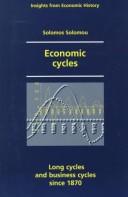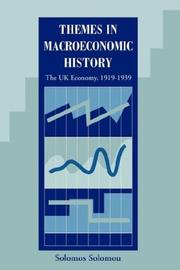| Listing 1 - 10 of 10 |
Sort by
|

ISBN: 0719041511 0719041503 Year: 1998 Volume: *2 Publisher: Manchester : Manchester university press,
Abstract | Keywords | Export | Availability | Bookmark
 Loading...
Loading...Choose an application
- Reference Manager
- EndNote
- RefWorks (Direct export to RefWorks)
Business cycles --- Conjoncture économique --- Conjunctuur --- Cycles économiques --- Economic cycles --- Economic fluctuations --- Economic forecasting --- Economic stabilization --- Economische stabilisatie --- Economische vooruitzichten --- Perspective économique --- Projection économique --- Prévision économique --- Prévisions économiques --- Stabilisation économique --- -338.542 --- Cycles --- Financial crises --- History

ISBN: 0521389046 0521334578 0511720637 9780521334570 9780521389044 9780511720635 Year: 1987 Publisher: Cambridge: Cambridge university press,
Abstract | Keywords | Export | Availability | Bookmark
 Loading...
Loading...Choose an application
- Reference Manager
- EndNote
- RefWorks (Direct export to RefWorks)
Solomos Solomou presents a clear and systematic examination of the evidence for long-term patterns of economic growth. Using data on Britain, France, Germany, the USA and the world economy between 1850 and 1973 he refutes the existence of long (Kondratieff) waves in the course of economic development. Instead he presents persuasive evidence for a growth pattern characterised by shock-induced, long-term variations in growth at the level of the world economy. The findings show that national patterns of growth did not necessarily coincide with those of the world economy, but followed episodic long swing fluctuations of twenty to thirty years before the Second World War and trend-accelerated growth in the post-war period. The author provides new historical perspectives on the pre-1913 era, the inter-war years and the post-war boom.
Long waves (Economics) --- Cycles longs (Economie politique) --- economische conjunctuur --- -Long waves (Economics) --- -Kondratieff cycles (Economics) --- Economic growth --- World history --- anno 1800-1999 --- Economic development --- economische groei --- geschiedkundige beschrijvingen --- 331.04 --- 331.100 --- 331.101 --- AA / International- internationaal --- Kondratieff cycles (Economics) --- Business cycles --- Economics --- Econometric models --- Langdurige bewegingen --- Economische geschiedenis: algemeenheden --- Geschiedenis van de economische cyclussen --- Econometric models. --- Economic history --- Développement économique --- Histoire économique --- Modèles économétriques --- Business, Economy and Management --- Long waves (Economics) - Econometric models --- Economic development - Econometric models --- HISTOIRE ECONOMIQUE --- CYCLES ECONOMIQUES --- 19E-20E SIECLES

ISBN: 0521436214 052143033X 0511599226 Year: 1996 Publisher: Cambridge : Cambridge University Press,
Abstract | Keywords | Export | Availability | Bookmark
 Loading...
Loading...Choose an application
- Reference Manager
- EndNote
- RefWorks (Direct export to RefWorks)
The period between the two World Wars was remarkable; mass unemployment, protectionism, diverse exchange rate regimes, the disintegration of world trade, poor growth prospects and high business cycle volatility. This comprehensive textbook surveys key questions arising from the British economy from 1919 to 1939: Why was unemployment so high? Did a fast transition to the pre-1913 gold parity lead to a low growth equilibrium? Why were interwar business cycles so volatile? Did tariffs stimulate economic recovery in the 1930s? A comparative approach is adopted throughout. For example, the question of gold parity is contrasted with countries that allowed their currencies to depreciate. The book is aimed primarily at students studying economic history. The book continually applies economic theory to historical examples enabling students to evaluate the relevance of competing theoretical frameworks.
Great Britain --- Economic conditions --- Economic policy --- Business, Economy and Management --- Economics
Book
Year: 1989 Publisher: Brussels Vrije Universiteit
Abstract | Keywords | Export | Availability | Bookmark
 Loading...
Loading...Choose an application
- Reference Manager
- EndNote
- RefWorks (Direct export to RefWorks)
Book
ISBN: 9780511599224 9780521430333 9780521436212 Year: 1996 Publisher: Cambridge Cambridge University Press
Abstract | Keywords | Export | Availability | Bookmark
 Loading...
Loading...Choose an application
- Reference Manager
- EndNote
- RefWorks (Direct export to RefWorks)

ISBN: 052138267X 052107178X 0511896050 9780521382670 9780511896057 9780521071789 Year: 1990 Publisher: Cambridge: Cambridge university press,
Abstract | Keywords | Export | Availability | Bookmark
 Loading...
Loading...Choose an application
- Reference Manager
- EndNote
- RefWorks (Direct export to RefWorks)
The impact of protectionism is currently a contentious policy issue. This book evaluates the effects of protectionism on the British interwar economy. In contrast to most studies of the period and the conclusions of orthodox economic theory, Kitson and Solomou show that the introduction of the General Tariff in 1932 provided a substantial stimulus to the domestic economy - a stimulus which can help to explain the trend improvement in British economic growth in the 1930s. The authors show that the tariff made encouraging import substitution and macroeconomic expansion. The empirical evidence is examined at two levels. First, a sectoral study shows that the newly protected sector of the 1930s saw an improvement in performance following the introduction of the tariff. Secondly, the large fall in manufacturing imports generated favourable effects on macroeconomic performance by helping to reduce the import propensity of the economy. The policy implication of this study is that trade policies should be constructed in the context of prevailing economic conditions and not solely with reference to sometimes inappropriate theoretical perspectives.
Foreign trade policy --- Great Britain --- Tariff --- Protectionism --- History --- 339.545<41> --- -Tariff --- -338 (41) --- Ad valorem tariff --- Border taxes --- Customs (Tariff) --- Customs duties --- Duties --- Fees, Import --- Import controls --- Import fees --- Tariff on raw materials --- Commercial policy --- Indirect taxation --- Revenue --- Customs administration --- Favored nation clause --- Non-tariff trade barriers --- Reciprocity (Commerce) --- Free trade and protection --- Boycot. Contingentering. Handelsbelemmering. Embargo. Handelsoorlog. Protectionisme. Discriminatie. Autarchie--Verenigd Koninkrijk van Groot-Brittannië en Noord-Ierland --- -Economische situatie. Economische structuur van bepaalde landen en gebieden. Economische geografie. Economische produktie.economische produkten. Economische diensten--Verenigd Koninkrijk van Groot-Brittannië en Noord-Ierland --- Economic conditions --- -Economic policy --- 338 (41) Economische situatie. Economische structuur van bepaalde landen en gebieden. Economische geografie. Economische produktie.economische produkten. Economische diensten--Verenigd Koninkrijk van Groot-Brittannië en Noord-Ierland --- Economische situatie. Economische structuur van bepaalde landen en gebieden. Economische geografie. Economische produktie.economische produkten. Economische diensten--Verenigd Koninkrijk van Groot-Brittannië en Noord-Ierland --- 339.545<41> Boycot. Contingentering. Handelsbelemmering. Embargo. Handelsoorlog. Protectionisme. Discriminatie. Autarchie--Verenigd Koninkrijk van Groot-Brittannië en Noord-Ierland --- -339.545<41> --- -Foreign trade policy --- -Protectionism --- 338 (41) --- Economic policy --- Business, Economy and Management --- Economics --- Tariff - Great Britain - History - 20th century. --- Protectionism - Great Britain - 20th century.
Book
ISBN: 1462326838 1452789630 128160304X 1451893353 9786613783738 Year: 2003 Publisher: Washington, D.C. : International Monetary Fund,
Abstract | Keywords | Export | Availability | Bookmark
 Loading...
Loading...Choose an application
- Reference Manager
- EndNote
- RefWorks (Direct export to RefWorks)
The role of exchange rate flexibility in the periphery of the gold standard has been grossly overlooked. This paper builds a new dataset on trade-weighed exchange rates for the period 1870-1913 and finds that large currency movements in periphery countries operating inconvertible paper-money and silver-standard regimes induced major fluctuations in effective exchange rates worldwide. We relate the phenomenon to the international trade structure at the time and show that such currency fluctuations had powerful effects on trade flows. We conclude that nominal exchange rate flexibility in the periphery was an important ingredient of international payments adjustment under the gold standard.
Investments: Metals --- Foreign Exchange --- International Monetary Arrangements and Institutions --- Economic History: Macroeconomics and Monetary Economics --- Growth and Fluctuations: General, International, or Comparative --- Metals and Metal Products --- Cement --- Glass --- Ceramics --- Currency --- Foreign exchange --- Investment & securities --- Exchange rates --- Real effective exchange rates --- Real exchange rates --- Nominal effective exchange rate --- Gold --- Commodities --- United States
Digital
Abstract | Keywords | Export | Availability | Bookmark
 Loading...
Loading...Choose an application
- Reference Manager
- EndNote
- RefWorks (Direct export to RefWorks)
Digital
Abstract | Keywords | Export | Availability | Bookmark
 Loading...
Loading...Choose an application
- Reference Manager
- EndNote
- RefWorks (Direct export to RefWorks)
Book
Year: 1989 Publisher: Brussels
Abstract | Keywords | Export | Availability | Bookmark
 Loading...
Loading...Choose an application
- Reference Manager
- EndNote
- RefWorks (Direct export to RefWorks)
| Listing 1 - 10 of 10 |
Sort by
|

 Search
Search Feedback
Feedback About UniCat
About UniCat  Help
Help News
News